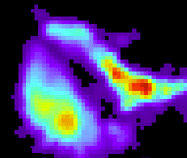Sensing Chair
Objective
- The long-term goal of this project is to develop a sensing chair that
can track its occupant's seating postures in real time using
surface-mounted pressure distribution sensors.
- The idea of a sensing chair was originally conceived while I was
working with
Alex (Sandy) Pentland
at the MIT Media Lab. Unlike many perceptual user interfaces for
smart environments that focus mainly on the automatic processing
of images and sounds using cameras and microphones, a sensing chair
tracks its occupant's postures with surface-mounted pressure
distribution sensors that function like a layer of "artificial skin".
Pressure sensors have been widely used for the evaluation of seats,
beds and shoes by furniture and shoe designers. The sensing chair
project is unique in that it uses pressure sensors in real-time
to drive other applications. For example, a sensing car seat
can automatically control the deployment force of an airbag; and a
sensing office chair can help its occupant maintain healthy postures
throughout the day.
Sensor Data
-


- Shown above are the pressure distribution patterns (in psydo color)
on the seatpan for seated upright (left) and for seated with left
foot on the
seatpan (right). The top and the bottom of the figures correspond
to the front and back of the torso, respectively.
The data are collected with the Body
Pressure Measurement System (BPMS) manufacturered by Tekscan Inc.
in South Boston, Massachusetts.
Reference
- Hong Z. Tan, Ifung Lu and Alex Pentland (1997).
"The chair as a novel haptic user interface." In Proceedings of
the Workshop on Perceptual User Interfaces, Oct. 19-21, Banff,
Alberta, Canada, 56-57.
HTML



